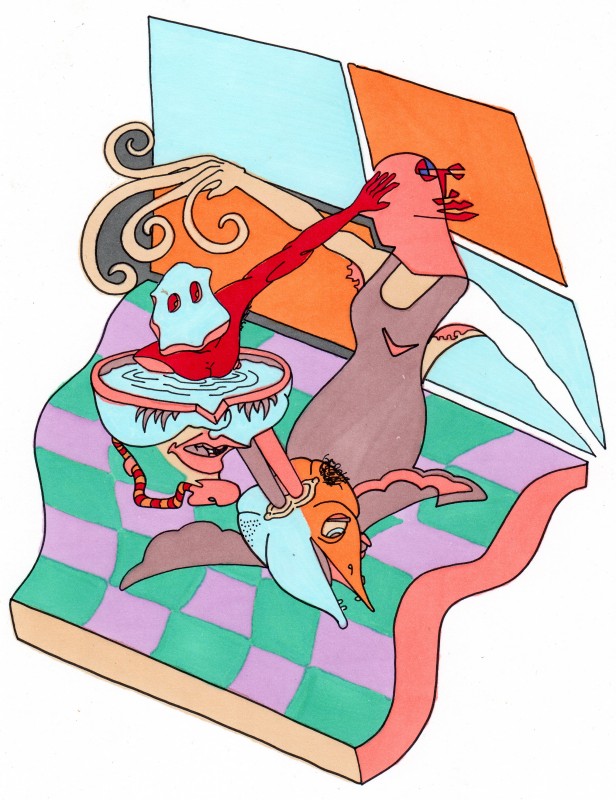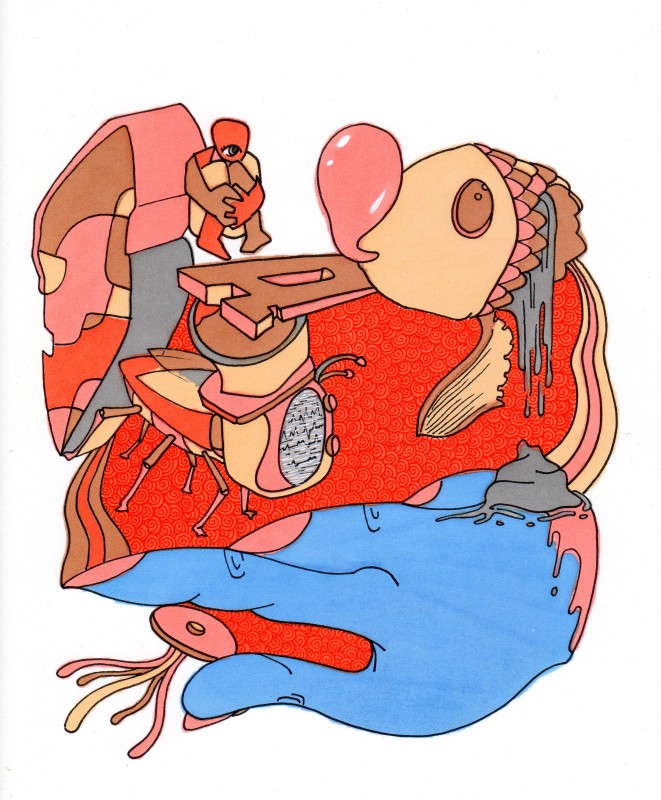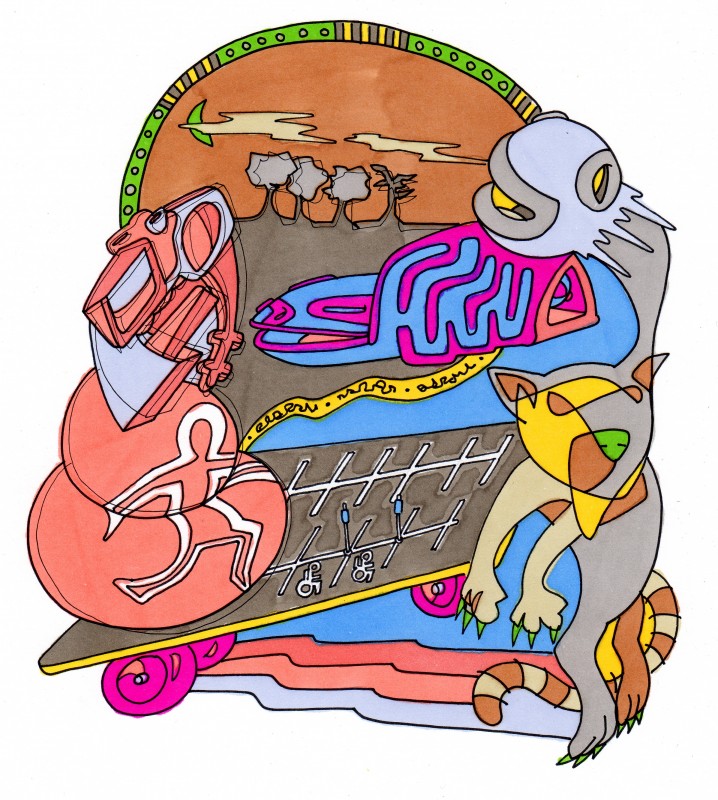
When Mary went for her morning swim at the complex pool she found a crowd gathered around the Jacuzzi. She stood next to Ted, a parboiled man in his fifties who was always touching Mary’s face. He found many pretenses: a gnat on her eyelash, a flake of dead skin on her chin. He moved aside now to let her see the orange fish head bobbing at the center of the Jacuzzi. The head was the size of an average microwave, one of the mutants from the sashimi farm two exits south on 101. But how had it gotten here?
The sashimi farm was attempting to engineer fish without heads, outsized tubes of exquisite fish meat. The cloning process, however, was not quite figured out. The geneticists did not know how to clone only the bodies. The heads had to be disposed of, which was problematic because the fish heads had, by a quirk of the cloning process, developed super intelligence. (Super for fish. By human standards they were still quite dumb.)
“Hey,” the fish head said to Mary. Mary shrieked and sheltered in the tuft between Ted’s pectorals. Ted stroked Mary’s cheek with his thumb, which Mary decided to allow.
The fish head looked sad. Jacuzzi bubbles filmed its eyes. The fish head did not move to displace them.
“How’d you get here, huh?” one of the terrifying runaway teenage girls asked the fish head. “You were telling us.”
The fish head silently bobbed.
“I think you offended it,” Ted told Mary. His pinkie probed her right nostril experimentally.
“Yeah, it was chatting up a storm before you screamed,” said another of the teenage girls.
Mary uncoupled her nose from Ted’s finger and retreated to her condo. The fish head said something in a low voice. Everyone laughed.

Mary turned on the TV to mask the voices of her neighbors, who were still gathered around the Jacuzzi questioning the fish head. Her TV was tuned to channel 23. Originally a sports channel, the network’s CEO had experienced a well-publicized psychotic break. The show that was now on, that had been broadcasted on this channel for 115 days straight, was a canceled drama called Lops’ Life, depicting the coming-of-age travails of a Cyclops teenager. In the first season, Lops is a gentle soul who plays the trombone and is mercilessly bullied. His only friend is a girl who is also othered due to a conspicuous set of braces. After the commercial failure of the critically acclaimed first season, a new creative team was hired. In the second season, Lops’ eye has inexplicably gained super powers which he wields against his former tormentors in a patient campaign of psychological terror.
In the first season episode currently broadcasting, a traveling salesman comes to the junior high school with trunks full of eyeglasses to sell to the students, who model frames for one another in the salesman’s trifold mirrors while Lops slips silently into the hall. Mary had seen this episode 34 times. Still she watched, rapt, as Lops fled from the school, pausing only to squeeze a vial of saline onto his giant lidless eyeball. In the next scene, the girl with braces knocked on Lops’ door bearing a monocle she’d made out of a clear shower curtain. Lops triumphantly wore the monocle to school, though it was evident the device was causing irritation to his vast cornea.
The credits rolled. Mary wiped the tears from her cheeks and rose to answer the knock at her door.

At Mary’s door stood the teenage runaway whose hair resembled a sheath of uncooked ramen noodles.
“There’s been a death,” the girl said.
“Excuse me?”
The girl sighed. “Someone died. Ted told me to get you.”
Sure enough, there was a chalk outline on the cement at the north end of the pool. The area was cordoned off by yellow police tape strung between traffic cones. No one had noticed, as they’d all been preoccupied with the fish head. The outline was drawn in the shape of a man with a giant round head and short, pudgy limbs, like an archetypal gingerbread man. The complex’s children had found it first and begun filling it in with a rainbow pattern of their own chalk, having been indoctrinated by coloring books to leave no outline unfilled. A red, non-chalk stain persisted in the head region.
“It was clearly a suicide,” Ted said. No one prompted him to elaborate.
A gray cat belonging to one of the runaways padded over and began licking the red stain, as if returning to a job after a break.
“Pringle, cut it out,” one of the girls said mechanically.
Everyone watched the cat lick the stain.
“Maybe the fish head saw something,” Mary said.
“We already asked it,” said the ramen-haired girl, rolling her eyes.
“The reason I say suicide,” Ted said, “is because of all the outlets.” He indicated with a sweep of his arm the dozens of electrical outlets lining the shed where the chairs were kept. Last winter, a group of residents suffering from Seasonal Affective Disorder (SAD) had insisted the outlets be installed to power their SAD light boxes while they were sunbathing, hoping that the superabundance of lux would bludgeon their mild mood disorders into submission.
In the distance, a rumbling.

[EXPLANATION OF SETTING] The complex is located in a satellite blind spot engineered by the United States government. Residents have come fleeing various threats. They leave the complex only by dying or by tiring of the complex’s social politics and deciding to risk life outside. Leaving necessitates the completion of numerous forms and a waiting period during which the forms are processed.
A military aircraft tore the sky above their heads before diminishing to a blip on the western horizon. A wooden crate affixed to a small parachute floated down to land in the pool. Ted nudged the box ashore with a net on a pole. Inside were the food and toiletry items ordered by residents the night before via an encrypted form on an unindexed site maintained by the National Geospatial-Intelligence Agency (NGA).
“Let’s check the parking lot,” the ramen-haired girl said, her mouth full of honey mustard Kettle Chips.
The unnamed majority of the crowd, the textual equivalent of a pre-Renaissance head cluster, returned to their condos. Mary, Ted, the ramen-haired girl and the gray cat headed to the parking lot to look for strange vehicles. Through the netting of prophylactic drones, Mary watched the sun set in a clamor of red and orange. She squinted at a flaw in the blaze. A figure approached, plastic wheels shucking against cracks in the pavement.
The skateboarder’s pudgy body was filmed in a quantity of sweat incongruous with the brisk evening. Never before, in the two years since Mary arrived at the complex, had anyone successfully breached the drone veil. There had been plenty of corpses at the perimeter.
“Sup,” said the skateboarder, in the moment before Ted and Mary and the ramen-haired girl tackled him to the concrete.

For interrogation they used the sauna. The ramen-haired girl dragged a pool chair in and Ted pinioned the skateboarder’s dimpled limbs to it with strapping tape. The fetters were loose and the geometry of the chair allowed the skateboarder to recline in a leisurely posture. Ted stood behind the skateboarder and mimicked the questioning styles of various television detectives while massaging the skateboarder’s shoulders. They hoped the sauna would sweat the truth out of him, but the skateboarder became increasingly relaxed until he dozed off. Mary roused him by cutting an apple and gently nudging the slices between his lips.
The skateboarder said he had just been looking for a place to watch the sunset. He had not noticed any sort of futuristic laser web. This meant that the net had been compromised, the complex rendered suddenly defenseless. Mary grew fond of the boy as he described his upbringing in a nearby suburb as the son of a prominent gastroenterologist. They shielded the tiny circular window of the sauna when they heard the hissing sound of surveillance drones making their hourly rounds; these drones would execute the skateboarder the moment their optical scanners detected he was not in the resident database.
By midnight, Mary’s bones had gone to noodles. She lay on hot planks and surrendered her face to Ted’s muscular hands. It was forbidden to ask from what or whom another resident had fled, but in the sauna the three residents began to disclose their backstories, starting with the ramen-haired girl. The teenage girls had arrived one at a time over three weeks in March. They knew each other already, though they pretended not to, resulting in a cloying comedy of errors that lasted far too long for Mary’s taste.

It was near dawn when the ramen-haired girl finished the story of how she and other members of the all-girls Christian rap group Reignbowz had ended up at the complex after becoming high-level drug informants for the FBI as part of a plea deal for stealing several hundred dollars’ worth of sparkly bangles from a Claire’s accessories store in a Pensacola mall.
“No shit! Reignbowz!” the skateboarder said. “We played your mix tape at youth group.”
The ramen-haired girl, who went by the name Swagdalena, brushed a sodden plait of curly hair from her face. “Now there’s 200k on each of our heads,” she said. “A cool million for all four of us.”
“There must be a billion dollars in combined bounty for all the residents here,” Ted said. He then launched into the story of how he’d come to the complex without first asking if anyone needed a break to use the bathroom or get a drink. He was describing the difficult circumstances of his birth when a roach crawled through the crack beneath the sauna door. It crawled up the skateboarder’s calf and perched just above his knee. It regarded him, antennae wiggling.
“Ugh, get it off me!” the skateboarder said, as his arms and legs were still strapped to the chair.
There was a clicking sound, and then a little pew as the roach-shaped drone opened its mouth to disgorge a laser-guided bullet. The bullet hit the skateboarder between his eyes, killing him instantly.

It was a ten-minute drive from the complex to a public beach where dozens of surfers politely ignored Mary as she staggered under the weight of the fish head. Its open neck was sticky with a sort of clone effluvium. The fish head seemed embarrassed. It kept apologizing and saying things like “Oh, jeez,” when its gills sluiced additional milky sap down the front of Mary’s dress.
The others would not have allowed her to go. All morning the fish head had begged them to release it to the ocean, since they kept talking about how they were going to be killed soon anyway. Mary waited until the residents padlocked themselves in the game room for a strategy session, then strapped the fish head into the passenger seat of her Honda.
Now, Mary nudged the fish head into the surf. She watched its orange, roughly pyramidal body float on the surface of a receding wave. A new wave broke, and the fish head was gone. Mary pressed her spine into the wet, cold sand. A thick layer of cloud shielded her from the cameras mounted on her family’s satellites, but she knew this protection bought her only a few minutes. By now her car’s license plate had been photographed and transmitted by dozens of drones.
Mary walked up the beach to shelter inside a famous seaside Taco Bell. She licked rehydrated beans from the tines of a plastic fork and watched the surfers, their bodies sleek in wetsuits. The sky above them darkened as the vessel descended. Mary stuffed her cardigan pockets with paper napkins and packets of hot sauce in preparation for her long journey.
Brooklyn-based artist Toby Goodshank made his high-profile musical debut playing acoustic guitar in The Moldy Peaches, but had long before embarked on a prolific solo career, recording and self-releasing 14 albums in a five-year span. In 2013 he co-founded the 3MB art collective with Adam Green and Macaulay Culkin. He has recently toured the US and UK as a solo act and as a member of The Pizza Underground and Adam Green’s band. This winter he will play bass on tour with Darwin Deez.
Kate Folk’s stories have appeared in the Baltimore Review, Monkeybicycle, Colorado Review, Word Riot, and elsewhere. She has attended residencies at the Virginia Center for the Creative Arts and the Vermont Studio Center, and was a 2014 fellow at the San Francisco Writers’ Grotto. Originally from Iowa, she now lives in San Francisco and works as an English teacher.